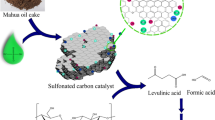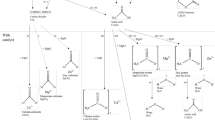Abstract
The conversion of cellulose to petroleum-like fuel is a very challenging yet attractive route to developing biomass-to-fuel technology. Many attempts have been made in liquefaction, pyrolysis and gasification of cellulose to produce fuels or intermediate chemicals. Previous studies indicate that these processes are tough. Hence, the present work is concerned with the development of new technologies for the conversion of cellulose into materials which are analogies to the precursor of petroleum. Montmorillonite-catalyzed hydrothermal carbonization of microcrystalline cellulose for the production of kerogen-like hydrochar under mild conditions was investigated. It was revealed that the hydrothermal carbonization of microcrystalline cellulose alone resulted in hydrochar with type III kerogen-like structure, whereas in the presence of montmorillonite, the hydrothermal carbonization of microcrystalline cellulose yielded a hydrochar-mineral complex, of which the isolated organic fraction was oil-prone type II kerogen-like structure. Results suggested that further improved montmorillonite-aided biomass conversion to more oil-prone kerogen-like solid products could be an alternative efficient route to obtain biofuel and chemicals.







Similar content being viewed by others
References
Bakandritsos A, Steriotis TH, Petridis D (2004) High surface area montmorillonite-carbon composites and derived carbons. Chem Mater 16:1551–1559
Ballice L, Yüksel M, Saglam M, Schulz H, Hanoglu C (1995) Application of infrared spectroscopy to the classification of kerogen types and the thermogravimetrically derived pyrolysis kinetics of oil shales. Fuel 74:1618–1623
Bedioui F (1995) Zeolite-encapsulated and clay-intercalated metal porphyrin, phthalocyanine and Schiff-base complexes as models for biomimetic oxidation catalysts: an overview. Coordin Chem Rev 144:39–68
Brow DR, Rhodes CN (1997) Brønsted and Lewis acid catalysis with ion-exchanged clays. Catal Lett 45:35–40
Chen LF, Liang HW, Cui CH, Lu Y, Yu SH (2011) Synthesis of an attapulgite Clay@Carbon nanocomposite adsorbent by a hydrothermal carbonization process and their application in the removal of toxic metal ions from water. Langmuir 27:8998–9004
Dinsmore HL, Nagy S (1974) Improved colorimetric determination for furfural in citrus juices. J AOAC 57:332–335
Espitalie J, Madec M, Tissot B (1980) Role of mineral matrix in kerogen pyrolysis: influence on petroleum generation and migration. AAPG Bull 64(1):59–66
Falco C, Baccile NM, Titirici M (2011) Morphological and structural differences between glucose, cellulose and lignocellulosic biomass derived hydrothermal carbons. Green Chem 13:3273–3281
Forsman JP, Hunt JM (1958) Insoluble organic matter (kerogen) in sedimentary rocks. Geochim CosmoChim Ac 15:170–182
French AD (2014) Idealized powder diffraction patterns for cellulose polymorphs. Cellulose 21:885–896
French AD, Santiago Cintrón M (2013) Cellulose polymorphy, crystallite size, and the Segal crystallinity index. Cellulose 20:583–588
Funke A, Ziegler F (2010) Hydrothermal carbonization of biomass: a summary and discussion of chemical mechanisms for process engineering. Biofuel Bioprod Bior 4:160–177
Ganz H, Kalkreuth W (1987) Application of infrared spectroscopy to the classification of kerogen types and the evaluation of source rock and oil shale potentials. Fuel 66:708–711
Gao Y, Wang X, Wang J, Li X, Cheng J, Yang H, Chen H (2013) Effect of residence time on chemical and structural properties of hydrochar obtained by hydrothermal carbonization of water hyacinth. Energy 58:376–383
Garcette-Lepecq A, Derenne S, Largeau C, Bouloubassi L, Saliot A (2000) Origin and formation pathways of kerogen-like organic matter in recent sediments off the Danube delta (northwestern Black Sea). Org Geochem 31:1663–1683
Gonzalez JM, Laird DA (2006) Smectite-catalyzed dehydration of glucose. Clay Clay Miner 54:38–44
Ibarra J, Muñoz E, Moliner R (1996) FTIR study of the evolution of coal structure during the coalification process. Org Geochem 24:725–735
Kabyemela BM, Adschiri T, Malaluan RM, Arai K (1999) Glucose and fructose decomposition in subcritical and supercritical water: detailed reaction pathway, mechanisms, and kinetics. Ind Eng Chem Res 38:2888–2895
Lin R, Ritz GP (1993) Reflectance FT-IR microspectroscopy of fossil algae contained in organic-rich shales. Appl Spectrosc 47:265–271
Lis GP, Mastablez M, Schimmelmann A, Lewan MD, Stankiewicz BA (2005) FTIR absorption indices for thermal maturity in comparison with vitrinite reflectance R0 in type-II kerogens from Devonian black shales. Oro Geochem 36:1533–1552
Madejova J (2003) FTIR techniques in clay mineral studies. Vib Spectrosc 31:1–10
Mesquita JP, Reis LS, Purceno AD, Donnici CL, Lago RM, Pereira FV (2013) Carbon–clay composite obtained from the decomposition of cellulose nanocrystals on the surface of expanded vermiculite. J Chem Technol Biot 88:1130–1135
Miller GL (1959) Use of dinitrosalicylic acid reagent for determination of reducing sugar. Anal Chem 31:426–428
Nishiyama Y, Langan P, Chanzy H (2002) Crystal structure and hydrogen-bonding system in cellulose Ib from synchrotron X-ray and neutron fiber diffraction. J Am Chem Soc 124(31):9074–9082
Painter PC, Snyder RW, Starsinic M, Coleman MM, Kuehn DW, Davis A (1981) Concerning the application of FT-IR to the study of coal: a critical assessment of band assignments and the application of spectral analysis programs. Appl Spectrosc 35:475–485
Pranger L, Tannenbaum R (2008) Biobased nanocomposites prepared by in situ polymerization of furfuryl alcohol with cellulose whiskers or montmorillonite clay. Macromolecules 41:8682–8687
Sakanishi K, Ikeyama N, Sakaki T (1999) Comparison of the hydrothermal decomposition reactivities of chitin and cellulose. Ind Eng Chem Res 38:2177–2181
Seewald JS (2003) Organic–inorganic interactions in petroleum-producing sedimentary basins. Nature 426:327–333
Segal L, Creely JJ, Martin AE Jr, Conrad CM (1959) An empirical method for estimating the degree of crystallinity of native cellulose using the X-ray diffractometer. Tex Res J 29:786–794
Sevilla M, Fuertes AB (2009) The production of carbon materials by hydrothermal carbonization of cellulose. Carbon 47:2281–2289
Sugiyama J, Okano T, Yamamoto H, Horii F (1990) Transformation of Valonia cellulose crystals by an alkaline hydrothermal treatment. Macromolecules 23:3196–3198
Tissot B, Welte DH (1984) Petroleum formation and occurrence, 2nd edn. Springer-Verlag, Berlin
Tong DS, Xia X, Luo XP, Wu LM, Lin CX, Yu WH, Zhou CH (2013) Catalytic hydrolysis of cellulose to reducing sugar over acid-activated montmorillonite catalysts. Appl Clay Sci 74:147–153
Vaccari A (1998) Preparation and catalytic properties of cationic and anionic clays. Catal Today 41:53–71
Vandenbroucke M, Largeau C (2007) Kerogen origin, evolution and structure. Oro Geochem 38:719–833
Wada M, Sugiyama J, Okano T (1995) Two crystalline phase (Iα/Iβ) system of native celluloses in relation to plant phylogenesis. Mokuzai Gakkaishi 40:50–56
Wada M, Hori R, Kim UJ, Sasaki S (2010) X-ray diffraction study on the thermal expansion behavior of cellulose Iβ and its high-temperature phase. Polym Degrad Stab 95:1330–1334
Wang CC, Juang LC, Hsu TC, Lee CK, Lee JF, Huang FC (2004) Adsorption of basic dyes onto montmorillonite. J Colloid Interface Sci 273:80–86
Wu CN, Saito T, Fujisawa S, Fukuzumi H, Isogai A (2012a) Ultrastrong and high gas-barrier nanocellulose/clay-layered composites. Biomacromolecules 13:1927–1932
Wu LM, Zhou CH, Keeling J, Tong DS, Yu WH (2012b) Towards an understanding of the role of clay minerals in crude oil formation, migration and accumulation. Earth-Sci Rev 115:373–386
Wu LM, Tong DS, Zhao LZ, Yu WH, Zhou CH, Wang H (2014) Fourier transform infrared spectroscopy analysis for hydrothermal transformation of microcrystalline cellulose on montmorillonite. Appl Clay Sci 95:74–82
Xiao LP, Shi ZJ, Xu F, Sun RC (2012) Hydrothermal carbonization of lignocellulosic biomass. Bioresour Technol 118:619–623
Yan W, Acharjee TC, Coronella CJ, Va´squez VR (2009) Thermal pretreatment of lignocellulosic biomass. Environ Prog Sustain Energy 28:435–440
Yen TF, Wu WH, Chilingar GV (1984) A study of the structure of petroleum asphaltenes and related substances by infrared spectroscopy. Energy Sources 7:203–235
Yu Y, Wu H (2009) Characteristics and precipitation of glucose oligomers in the fresh liquid products obtained from the hydrolysis of cellulose in hot-compressed water. Ind Eng Chem Res 48:10682–10690
Zhou CH, Keeling J (2013) Fundamental and applied research on clay minerals: from climate and environment to nanotechnology. Appl Clay Sci 74:3–9
Zhou CH, Xia X, Lin CX, Tong DS, Beltramini J (2011) Catalytic conversion of lignocellulosic biomass to fine chemicals and fuels. Chem Soc Rev 40:5588–5617
Zugenmaier P (2008) Cellulose. In crystalline cellulose and cellulose derivatives: Characterization and structures. Springer Series in Wood Science Berlin, Heidelberg, Springer, New York, p 72
Acknowledgments
The authors wish to acknowledge the financial support from the National Natural Scientific Foundation of China (21373185), the Distinguished Young Scholar Grants from the Natural Scientific Foundation of Zhejiang Province (ZJNSF, R4100436), ZJNSF (LQ12B03004), Zhejiang “151 Talents Project”, and the projects (2010C14013 and 2009R50020-12) from Science and Technology Department of Zhejiang Provincial Government and the financial support by the open fund from Key Laboratory of Clay Minerals of the Ministry of Land and Resources, China.
Author information
Authors and Affiliations
Corresponding author
Rights and permissions
About this article
Cite this article
Wu, L.M., Zhou, C.H., Tong, D.S. et al. Novel hydrothermal carbonization of cellulose catalyzed by montmorillonite to produce kerogen-like hydrochar. Cellulose 21, 2845–2857 (2014). https://doi.org/10.1007/s10570-014-0323-2
Received:
Accepted:
Published:
Issue Date:
DOI: https://doi.org/10.1007/s10570-014-0323-2




